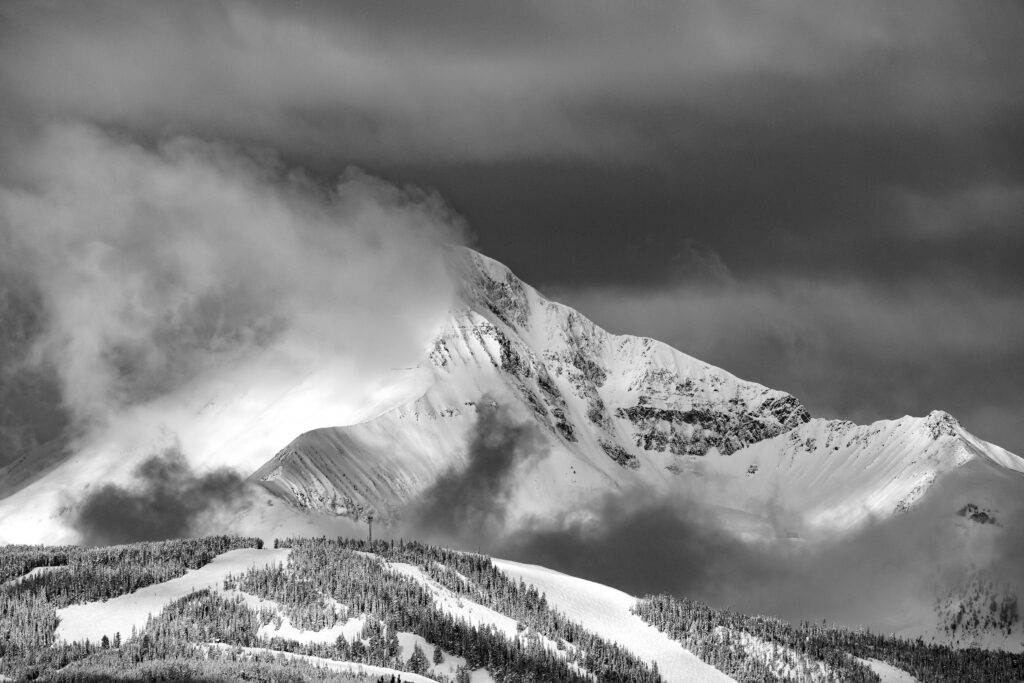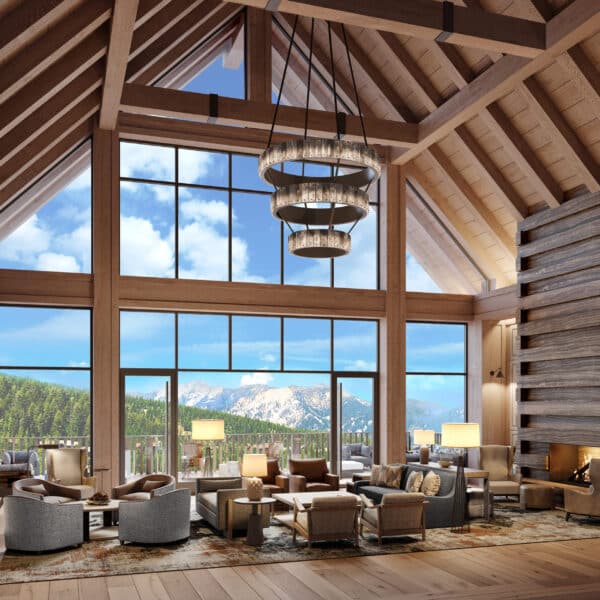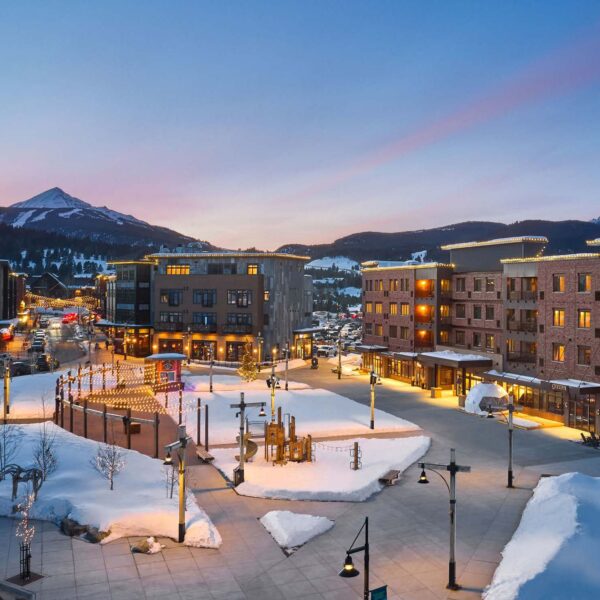Big Sky, Montana

Mountain Weather. Mountain Snow, Mountain Sense
Does that chute cliff out? Will the kids like this run?
Is that ice or wet snow on that face?
Can the snowboarder in the crew glide this traverse?
Is the Big Couloir beyond my ski level?
To be a skier is to hone your mountain sense. It begins with knowing mountain weather—and the everchanging snowpack that makes skiing and snowboarding so rewarding. Such knowledge develops as you put yourself on the hill, maybe sliding down a run on your backside, or enduring a gale that’s growing rime ice on your whiskers. But the organic mountain sense can take decades to develop, and Big Sky’s more serious terrain demands too much respect to dive in unwittingly. This will get you started.

Be a Mountain Weather Savant
Want to track storms heading to Big Sky?
Here’s how the professionals do it.
“As snow forecasting in Montana goes,” says OpenSnow Montana Forecaster Bob Ambrose, “Big Sky is actually pretty easy. It’s a rare area where you see regular weather patterns.”
Here’s the first thing to look for according to Ambrose. When Jackson Hole and Targhee are calling for big storms, that typically means a front is tracking from the west by southwest. The Tetons, because they run north and south with high plains to the west, catch a ton of that moisture courtesy of orographic lift—when warm air cools as it rises to get over the range, it can’t hold as much moisture so in winter it falls as snow.
Lone Peak—a solitary volcano that never erupted—doesn’t share the topography of the Tetons, but unlike most Montana ski areas, it benefits from those southwesterlies. “Big Sky gets the residuals of those Targhee storms,” says Ambrose. “That’s when we get those persistent systems that can drop six inches every night for half a week or more. In the early season right through February, that’s the best situation for Big Sky. You don’t typically get massive dumps from those early spillover storms, but you get rapid improvement in skiing conditions, and windbuff and wind-reloaded skiing too. It’s with that southwesterly flow that Big Sky will see storms that miss Bridger entirely. By March and April, that storm track can come through with even more moisture. Those spring southwesterlies can drop a foot or two at a time.”
This is not a guessing game scenario. OpenSnow, originally a Colorado outfit that now forecasts snowfall around North America, relies on a map that combines the European, Canadian, and U.S. National Weather Service models—much like projecting a hurricane. “I base my Montana forecasts and reports off that same map and back it up with the readings from SNOTEL sites (Snow Telemetry stations) and mountain reports,” says Ambrose. “The public can see it too if they sign up at the OpenSnow All-Access level.”
That’s the southwesterly pattern, but Big Sky also benefits from a northwesterly flow that brings moisture from the Pacific Northwest and southwestern Canada. After that low pressure spills over the Continental Divide, it heads south along the Rocky Mountain Front—and often straight into Big Sky. “Those northwesterly storms saved our season last winter,’’ says Big Sky Ski Patrol Director Ryan Ayres. “They also make for great skiing because they tend to come in with less wind. When the upper mountain is blanketed in fluff, that’s usually a storm from the northwest.”
To track those events, says Ambrose, it’s probably best to ignore the storms coming out of the Gulf of Alaska, because they tend to only target British Columbia. “But if you see that Whitewater ski area in western BC is getting hammered, it’s fair to get your hopes up,” says Ambrose. “I routinely follow that pattern all the way down into southwest Montana.”
When in doubt, tune into the Big Sky Resort snow reports each morning, produced in concert with Big Sky Ski Patrol. “We have a strong Snow Safety Team (avalanche mitigation) that’s forecasting every day,” says Ayres. “They’re looking at storm tracks from around the region and making the best predictions. Every morning they’re looking at radar and snow by 5:00 AM. Then we’re on the lift at 7:00 AM or earlier making observations. That information gets shared with the snow reporters.”
La Niña or La Nada?
There’s an 87 percent chance of a La Niña weather pattern this winter. That’s certainly not bad news, but does the weather pattern live up to the hype?
The term La Niña refers to an anomaly in which the surface water temperatures in the equatorial pacific are cooler than usual. When that settles in, the odds of a colder and slightly wetter winter go up in the Northern Rockies, resulting in much rejoicing. But does it pan out? Well, it’s no sure thing:
OpenSnow Forecaster Bob Ambrose’s Take: “None of us at OpenSnow put a lot of stock into it. Last year we had about a 70 percent chance of a La Niña. This year it’s 87 percent, which is better, but we all saw what happened last year. We had 174 inches of snow at Big Sky. I did a recap on it. We came out about 68 percent of average last year. Even though the snowpacks for the Gallatin were 90 percent, the resort didn’t do as well. That’s from their reports. This year, 87 percent is more promising. I’d take that as a slightly better chance of colder temps and above average precipitation. If that happens we’ll be doing OK.”
Big Sky Resort Patrol Director Ryan Ayres’ Take: “We’ve tried to forecast off La Niña, but there are too many factors. How’s that working with the oscillations in the jet stream? What are the temperatures doing when the storm hits? I haven’t found a huge correlation. Aside from a couple of anomalies, the differences between our worst years and our best years are not that much. We live in that average world. Even in bad years we’re not far below average.”
The Ski·er’s Lex·i·con
/’sk’rs/ /’leksi’kän/
Windbuff noun
Meaning: Lightly redeposited snow driven by mild winds until it fills gaps in the snowpack and delivers a fast, soft, consistent surface.
Synonyms: Nature’s Grooming; Buff; Hero Snow.
Use windbuff in a sentence: “Mammoth Mountain, California, gets just the right wind speeds for windbuff, the only place I’ve ever seen it nearly as good is on the lower flanks of Headwaters.” —Bob Ambrose, Montana Forecaster, OpenSnow.

The Ski·er’s Lex·i·con
/’sk’rs/ /’leksi’kän/
Upside Down Snow noun
Meaning: Storms that start off warm and grow progressively colder lay down spongy snow that adheres to rocks and ice and then serve powder on top—this is snow in its Platonic form. When storms go cold-to-warm, though, you get the dreaded upside down snow—dry down low; wet up top—which makes for weird, grabby skiing.
Use upside down snow in a sentence: “I couldn’t get my tips to the surface. The quads were burning. It was untracked, but the snow wouldn’t blow up. The photographer was pissed. It was upside down snow.”

Photograph by Jonathan Finch
The Powder Seekers
Find snow when the winds blow.
Scot Schmidt, the godfather of extreme skiing, reads Lone Peak’s sastrugi (a Russian word for those wind eroded dunes in snow) to find powder. The OpenSnow forecaster Bob Ambrose is playing the wind as he explores the moun-tain. Patrol Director Ryan Ayres is always thinking about leeward slopes. If it hasn’t snowed in a few weeks, Big Sky snow reporter and athlete Joe Turner is in the Headwaters looking for chalk up high and redeposited powder down low. Which is to say that the skiing at Big Sky isn’t all laid out in front of you like it is at flat mountains like Vail and Steamboat. You need to become your own guide. Here’s an introductory course.
The Storm Came From the Southwest—With Winds Over 30 mph.
Southwesterly storms scour much of the upper mountain, but you checked it out anyway because you love the alpine. OK, the wind is gnarly, and you’re not feeling any of that new snow beneath your skis. Now what? As Ayres says, “that snow has to be going some-where, hopefully it’s not landing in Ennis.” In conditions like this, both Ayres and Turner head directly to the old Moonlight side (now called the North Side.) Says Turner: “Start on the North Ridge down lower beneath the Horseshoe Bowl and head into the trees. It’s all been gladed. Choke on powder in there for a bit and then head to Bavaria. It’s really fast skiing that’s well pitched for powder turns.”
The Ski·er’s Lex·i·con
/’sk’rs/ /’leksi’kän/
Chalk noun
Meaning: Cold, consolidated, edgeable, alpine snow typically found on north-facing or sheltered aspects.
Etymology: It’s white and dry and looks like chalk, but in reality it’s a helluva lot softer.
Use chalk in a sentence: “I had a day when the Lone Peak looked hammered. Nobody was up there. Then a wind picked up and I knew it would be good. We were skiing smoking chalk all afternoon; super-G turns down the Dictator Chutes.” —Scot Schmidt, Godfather of Extreme Skiing, Yellowstone Club Ambassador.
The Ski·er’s Lex·i·con
/’sk’rs/ /’leksi’kän/
Mank noun
Meaning: Snow in the trees that’s so heavy, wet, unconsolidated, and deep—and often scattered with moose dung and fallen lichen—that turning is challenging and can torque the knees.
Synonyms: Mashed Potatoes; Crud; Glop; Winter Quag.
Use mank in a sentence: “I dipped into the woods on Moonlight to-day and it was pure death mank in there. All the snow on the boughs was melting off, and between the tree bombs and the hot mank it was borderline unskiable.”
The Storm Came From the Southwest—With Winds Under 30 mph.
When the winds are light they drift and buff the alpine snow instead of scouring. Stop and think about what that means. The leeward sides of gullie walls will catch soft snow. So too with the hairball lines like Big and Little Couloir. “On those days with the winds below 30 you get that grooming effect,” says Ayres. “Check out skier’s right in the Gullies. The stuff on the North Side (Headwaters). And I never want to discount the Andesite zone because it’s not nearly as wind-affected.”
The Storm was Three Days Ago, but the Winds are Still From the Southwest.
Schmidt loves these days because over time those winds are picking up snow grain by grain and launching them into the air where they refreeze and dry out, before redistributing them where the savvy can find them. “That redeposited snow is so dry and so cold,” says Schmidt. “It can be just as light as the stuff that falls out of the sky. At these elevations it reforms and recrystallizes. It’s not a stiff deposit like a windslab. I call it recycled powder. At Big Sky you’ll find it on northerly aspects.” In the coming days, those soft conditions will per-sist—wherever the snow is ending up. That type of windbuff can make the alpine as easy to ski as a groomer.
The Storm Came From the North With Cold Temps.
Those southwesterly winds wrap around Lone Peak and mess with the orographic effect—more snow higher up. But when storms come from the north the upper mountain often wins. It’s on these days that you might see four inches of snow at the base—and a foot up high. “We can see it on our weather station instrumenta-tion,” says Ayres. “They’ll be a few inches on Lookout Ridge, a foot in the Yellowstone Club, and still more in Liberty Bowl.” When those dumps happen on a deep base, it can be game on. “I remember skiing the Liberty rope line all the way down Dakota Gully without stopping,” says Ayres. “I was barely able to hang on at the bottom. We were skiing over bands of rocks, but it didn’t matter. It was one of those rare days where you could ski between Lenin and Marx down low without being reminded that you’re on top of a pile of rocks.”
It Hasn’t Snowed in Weeks, but Temperatures Have Remained Cold.
“Lone Peak isn’t like any other North American ski area,” says Schmidt. “It’s like skiing in the Alps.” As such, you need to think like a guide. Schmidt follows the ripples in the sastrugi to steep, north facing ski-ing. The OpenSnow Montana Forecaster Bob Ambrose is after the same goods. “That chalky snow makes steep skiing more welcoming,” says Ambrose. “You can really dig an edge into it. Some of my best runs ever have been in the North Summit Snowfields in exactly those conditions. It’s as steep as Big Couloir if not steeper, but you’re skiing 4,440 vertical feet.” When those conditions set up, says Ayres “you can trust the chalky snow. You know you aren’t going to break through. The North Summit, Headwaters, when it’s tacky like that is amazing skiing. Chalk is underrated, but amazing.”
The Ski·er’s Lex·i·con
/’sk’rs/ /’leksi’kän/
Sucker Tracks noun
Meaning: Big Sky is famous for this weird dynamic of the human mind. A visiting skier will see untracked powder late in the day, dive in, and then limp out as their edges spark off rocks. Later, an unsuspecting “sucker” will follow the tracks, and the process repeats itself.
Synonyms: Gaper Bait, Fool’s Powder.
Etymology: Early Alta, Utah, ski patrollers, including Dave Hamre, who installed the Lone Peak Tram, took pleasure in laying down perfect figure eights in horrible snow—and then watching the customers explode on every second turn on the way down. Thus, “sucker tracks.”
Use sucker tracks in a sentence: “If there are no tracks in a zone it’s for a reason. Don’t go charging in when you’re exploring. Be smart about stuff. Skiing the expert terrain is like boating technical whitewater. Stop and assess your surroundings and identify your next point of safety. And don’t follow sucker tracks.” —Joe Turner, Big Sky Resort, Snow Reporter.
The Ski·er’s Lex·i·con
/’sk’rs/ /’leksi’kän/
Corn noun
Meaning: In spring, clear nights drop temperatures below freezing thanks to radiational cooling. Then warm rays from the sun melt the surface layers. This freeze/thaw cycle creates small corn-like kernels of snow and a uniform skiing surface for a few hours each day. Get there too soon and it’s ice, get there too late and the corn goes to mashed potatoes.
Synonyms: There’s actually nothing like it. Corn is the dream surface of ski mountaineers.
Use corn in a sentence: “When the corn cycle is in, you know it. All the logistics of your day are built around timing it right.” —Dougal McCarty, alpinist and first skier to descend Little Couloir via the Apple Core—he ate the eponymous apple.

Photograph by Ryan Turner

Luxury Hotels Are Building Hundreds of New High-end Vacation Homes — and We Got a Look Inside
More hotels are getting into the real estate game, selling private vacation homes that come with all the bells and whistles. Montage Hotels & Resorts may well be laying the most ambitious bets on the ownership model. At Montage Residences Big Sky, slated to open in Montana in November, 39 homes will range in size […]

Where America’s Wealthiest Are Staying This Memorial Day
Hotel prices for Memorial Day Weekend pack a punch, but for America’s one per cent the inflated costs are no problem. Consultants from Two Nights In – a luxury travel agency providing a VIP-style booking service – have revealed to DailyMail.com the most sought-after destinations in the US for those with cash to splash this upcoming vacation period. Coming […]

The Future of Big Sky
Lone Mountain Land Company’s Matt Kidd sat down to discuss the difference between development and nurtured growth, capacity and sustainability, and maintaining a sense of place while supporting the economy. When it comes to the Big Sky community, there’s good news, tough news, and inarguable news. The inarguable news first: The word is out. Big […]

